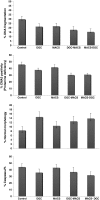Density gradient centrifugation before or after magnetic-activated cell sorting: which technique is more useful for clinical sperm selection?
- PMID: 22170231
- PMCID: PMC3252407
- DOI: 10.1007/s10815-011-9686-6
Density gradient centrifugation before or after magnetic-activated cell sorting: which technique is more useful for clinical sperm selection?
Abstract
Purpose: Although, at present, the selection of sperm prior to ICSI is based on motility and morphology, undetectable anomalies, and more importantly damaged DNA are overlooked. In this regard, novel sperm selection procedures have gained much interest. For instance, sperm has been selected by Magnetic-Activated Cell Sorting (MACS) based on early apoptotic marker, the externalization of phosphatidylserine (EPS). Review of the literature has revealed that the efficiency of this technique has been mainly evaluated post Density Gradient Centrifugation (DGC). Therefore, there is a need to prove the efficiency of this technique independent of DGC. In addition, considering the fact that DGC induces EPS due to capacitation and acrosome reaction, therefore, the role of MACS before DGC(MACS-DGC) and MACS after DGC (DGC-MACS) should be assessed.
Methods: Semen samples from fifteen infertile men were divided into three separate fractions: control, DGC, and MACS. To carry out DGC-MACS, DGC samples were further divided into two fractions and MACS was carried on the second fractions. Similarly to carry out MACS-DGC, the MACS samples were further divided into two fractions and DGC was carried on the second fractions. Percentages of sperm with normal morphology, DNA fragmentation, protamine deficiency, EPS and caspase-3 activity were determined in each fraction.
Results: DGC is more efficient than MACS in separating intact sperm only in terms of normal morphology, DNA and chromatin integrity but not for active caspase. However, a combination of these procedures was more efficient than a single procedure to separate intact sperm for the aforementioned parameters. Comparison of the combined procedures showed only higher efficiency to separate active caspase in the MACS-DGC group.
Conclusion: Based on these results, we propose MACS-DGC rather than DGC-MACS to be implemented in clinical settings.
Figures



Similar articles
-
Evaluation of ubiquitin and annexin V in sperm population selected based on density gradient centrifugation and zeta potential (DGC-Zeta).J Assist Reprod Genet. 2012 Apr;29(4):365-71. doi: 10.1007/s10815-011-9689-3. Epub 2011 Dec 20. J Assist Reprod Genet. 2012. PMID: 22183502 Free PMC article.
-
Zeta potential vs apoptotic marker: which is more suitable for ICSI sperm selection?J Assist Reprod Genet. 2013 Sep;30(9):1181-6. doi: 10.1007/s10815-013-0022-1. Epub 2013 Jul 19. J Assist Reprod Genet. 2013. PMID: 23868531 Free PMC article.
-
Efficient isolation of sperm with high DNA integrity and stable chromatin packaging by a combination of density-gradient centrifugation and magnetic-activated cell sorting.Clin Exp Reprod Med. 2016 Dec;43(4):199-206. doi: 10.5653/cerm.2016.43.4.199. Epub 2016 Dec 26. Clin Exp Reprod Med. 2016. PMID: 28090458 Free PMC article.
-
Improving ICSI: A review from the spermatozoon perspective.Syst Biol Reprod Med. 2016 Dec;62(6):359-371. doi: 10.1080/19396368.2016.1229365. Epub 2016 Sep 20. Syst Biol Reprod Med. 2016. PMID: 27646677 Review.
-
Sperm selection in assisted reproductive techniques.Soc Reprod Fertil Suppl. 2007;65:515-25. Soc Reprod Fertil Suppl. 2007. PMID: 17644989 Review.
Cited by
-
Novel Techniques of Sperm Selection for Improving IVF and ICSI Outcomes.Front Cell Dev Biol. 2019 Nov 29;7:298. doi: 10.3389/fcell.2019.00298. eCollection 2019. Front Cell Dev Biol. 2019. PMID: 31850340 Free PMC article. Review.
-
Effect of Sperm Selection by Magnetic-Activated Cell Sorting in D-IUI: A Randomized Control Trial.Cells. 2022 May 30;11(11):1794. doi: 10.3390/cells11111794. Cells. 2022. PMID: 35681488 Free PMC article. Clinical Trial.
-
New insights into semen separation techniques in buffaloes.Front Vet Sci. 2024 Jan 10;10:1347482. doi: 10.3389/fvets.2023.1347482. eCollection 2023. Front Vet Sci. 2024. PMID: 38269362 Free PMC article. Review.
-
Induction of Sublethal Oxidative Stress on Human Sperm before Cryopreservation: A Time-Dependent Response in Post-Thawed Sperm Parameters.Cell J. 2019 Jan;20(4):537-543. doi: 10.22074/cellj.2019.5639. Epub 2018 Aug 1. Cell J. 2019. PMID: 30124000 Free PMC article.
-
DNA fragmentation in human sperm after magnetic-activated cell sorting.J Assist Reprod Genet. 2015 Jan;32(1):147-54. doi: 10.1007/s10815-014-0370-5. Epub 2014 Nov 6. J Assist Reprod Genet. 2015. PMID: 25374393 Free PMC article.
References
-
- Paasch U, Grunewald S, Glander HJ. Sperm selection in assisted reproductive techniques. Soc Reprod Fertil Suppl. 2007;65:515–25. - PubMed
Publication types
MeSH terms
Substances
LinkOut - more resources
Full Text Sources
Research Materials
Miscellaneous

